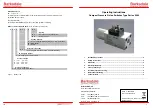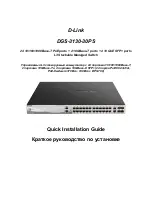
PHILIPS
PHILIPS
black
brass
ground
white
red
load
120-277 V~
50 / 60 Hz
hot/live
neutral
black
brass
ground
white
red
hot/live
neutral
120-277 V~
50 / 60 Hz
y
(4x)
(1x)
(1x)
PHILIPS
(2x)
PHI
LIPS
Installation Guide
OccuSwitch Wireless System
LRM172100 Switch
LRM173000 Dimmer
WARNING:
Wiring
the
wall
device
with
power
ON
is
unsafe
and
could
result
in
serious
injury
or
death.
Turn
Off
power
at
the
circuit
breaker
before
installing
the
Switches
and
Dimmers.
1
Switch
Off
line
voltage
at
circuit
breaker.
Wiring
HOT
may
damage
the
electronic
and
void
the
war
‐
ranty.
2
Remove
the
old
Switch
and
install
new
OccuSwitch
Dimmer
or
Switch
following
the
wiring
diagram.
Note:
do
NOT
swap
Hot/live
and
neutral.
3
Wireless
remote
(3
‐
way)
devices
wire
as
follows:
The
master
dimmer
(that
controls
the
load)
accord
‐
ing
to
the
regular
wiring
diagram.
Wire
the
remote
switch/dimmer
(no
load)
accord
‐
ing
to
the
wiring
diagram.
Remote
(3
‐
way
grouping)
configuration
is
a
menu
option,
see
Configuration
instruction
(Yellow
#2)
on
back
page.
4
To
install
in
multi
‐
gang
wall
back
‐
box,
break
the
tabs
of
joining
sides.
Do
not
break
the
outside
tabs
on
devices
at
the
end
of
the
gang.
Up
to
3
devices
can
be
ganged
in
one
three
‐
gang
box.
5
Place
the
dimmer
into
the
wall
back
‐
box,
and
se
‐
cure
with
the
mounting
screws.
6
Power
the
circuit
at
fuse
or
circuit
breaker.
7
Check
operation
ON/OFF
or
Fade
Up/
Dim
Down.
Installation
Steps
1.
Install
wall
device
2.
Install
sensor
(separate
instructions)
3.
Link
devices
4.
Configure,
test
and
finish
Product
Description
OccuSwitch™
Wireless
automatically
controls
the
lights
based
on
occupancy
and
daylight.
The
system
has
two
parts:
ceiling
‐
mounted
sensor
and
wall
mount
power
handling
device
(switch
or
dimmer).
The
switch
will
turn
the
lights
On
and
Off
based
on
the
information
received
from
the
wireless
occupancy
sensor.
The
dimmer
will
dim
lights
Up
and
Down
to
the
appropriate
intensity
base
on
the
available
daylight
in
the
space.
The
dimmer
can
also
manually
dim
the
lights.
Key
figures
SAFETY
Parts
of
the
switch
&
dimmer
carry
line
power,
which
is
a
poten
‐
tial
lethal
voltage.
This
product
was
designed
and
manufactured
to
ensure
maximum
safety
during
operation
and
service.
Always
read
these
safety
instructions
before
installing,
maintaining
or
servicing
the
product,
and
strictly
comply
with
these
instruc
‐
tions.
General
‐
If
you
are
unsure
about
any
part
of
these
installation
instruc
‐
tions,
consult
a
qualified
electrician.
‐
The
devices
are
designed
for
indoor
use
only.
‐
To
avoid
short
circuits,
do
not
expose
this
product
to
rain
or
condensing
moisture.
Short
circuit
may
cause
fire
or
electric
shock
hazard.
Operate
the
devices
between
41°F
and
104°F
(5°C
and
40°C)
ambient
temperature.
.
‐
Use
only
a
soft
damp
cloth
to
clean,
never
use
any
abrasive
or
chemical
cleaner.
‐
Whenever
it
is
suspected
that
an
unsafe
condition
exists,
switch
off
power
at
the
circuit
breaker
and
replace
the
device.
Safety
is
likely
to
be
impaired
if,
for
example,
the
equipment
fails
to
perform
the
intended
functions
or
if
the
equipment
shows
visible
damage.
Do
not
paint
the
devices.
Wall
Device
(Switch
&
Dimmer)
only
‐
Disconnect
power
at
circuit
breaker
or
fuse
when
servicing,
installing
or
removing
the
fixture
of
the
switch.
‐
Only
use
with
copper
or
copper
clad
wire.
‐
Wire
switch
to
the
line
power
according
to
the
wiring
scheme
in
this
manual.
Sensor
only
‐
The
sensor
cannot
control
loads
directly
use
compatible
switch
or
dimmer.
‐
Use
only
high
‐
quality,
AA
size,
3.6V
lithium
‐
thionyl
chloride
batteries
with
the
sensor.
Using
improperly
rated
batteries
may
damage
the
sensor
or
fail
to
operate
properly.
‐
Dispose
of
used
batteries
promptly.
Keep
batteries
away
from
children,
do
not
disassemble
and
do
not
dispose
of
in
fire.
WARNING:
The
product
is
intended
to
control
lighting
loads
only.
Do
NOT
use
to
control
equipment
that
could
create
hazardous
situations,
like
entrapment.
For
examples,
do
NOT
install
this
product
to
control
motorized
gates,
garage
doors,
industrial
doors,
microwave
ovens,
heating
devices,
etc.
WARNING:
It
is
the
installer’s
responsibility
to
ensure
that
the
equipment
being
controlled
is
visible
from
every
control
location
and
that
only
suitable
equipment
is
connected
to
these
controls.
Failure
to
do
so
could
result
in
serious
injury
or
death.
CAUTION:
The
battery
used
with
the
sensor
device
may
present
a
risk
of
fire
or
chemical
burn
if
mistreated.
Do
not
recharge,
disassemble,
heat
above
100°C,
or
incinerate.
Replace
battery
with
Lithium
‐
thionyl
chloride
(AA
3.6V)
only.
Use
of
another
battery
may
present
a
risk
of
fire
or
explosion.
800VA
@
120VAC
(Mark10
or
equal)
1600VA
@
277VAC
(Mark10
or
equal)
800W
@120VAC
(Incandescent)
Not
recommended
but
it
works
Dimmer
NOT
rated
for:
Electro
Magnetic
Fluorescent
Motor
Loads
Switch
Load
Rating
1300VA
@120
or
277VAC
0.25
HP
@
120Vac
Switch
output
only
Network
Size
16
Sensors,
Switches
&
Dimmers.
Wireless
Range
Wall
device
to
sensor:
50ft
(17m)
Wall
devices
(same
plane)
18ft
(6
m)
Wall
devices
(line
of
sight)
50ft
(17m)
Dimen
‐
sions
‐
4.13”
x
2.56”in
x
1.79”
(105
x
65x
45mm)
Single
gang
wall
mount.2.5”
d
Dimmer
Load
Ratings
Environ
‐
mental
Temp:
40°F
to
104°F
(5°C
to
40°C)
Humidity:
20%
to
85%,
non
condensing
Wall
Device
box
contents
Indication
Meaning
Device
Red
,
Yellow
,
Green
Device
starts
up
or
reset
to
factory
defaults
All
Green
10
sec.
A
device
asked
to
show
all
linked
devices
All
1
Min.
Device
is
in
linking
mode
Switch
Dimmer
Yellow
Blink
Irregular
Sensor
is
showing
coverage
Sensor
Yellow
Blink
Every
2
Sec.
Device
is
in
the
configuration
menu
Switch
Dimmer
Red
Blink
Regular
A
linked
device
is
missing
(see
Troubleshooting
)
Switch
Dimmer
Red
Blink
2
Sec.
rate
Device
is
in
the
Action
menu
All
Steady
Yellow
Always
ON
Lights
are
switched
manually.
Automatic
mode
returns
after
vacancy
timeout.
Switch
Dimmer
Red
Blink
5
Sec
Rate
Sensor
Battery
Low
Switch
Dimmer
Red
Blink
2
Sec.
Rate
During
link
test
=
low
battery
Sensor
LED
and
Buttons
1
INSTALL
WALL
DEVICE
Note:
After
wall
device
is
installed
and
power
is
re
‐
turned,
test
all
wall
devices
by
pressing
the
rocker
switch
ON/OFF.
All
switches/dimmers
should
control
connected
loads.
If
they
do
not
control
the
lights
check
wiring.
Create
a
network:
To
create
a
wireless
net
‐
work
by
combination
of
up
to
16
switches,
dimmers
and
sensors
take
the
following
steps.
HINT:
to
prevent
cross
‐
linking
rooms
only
one
person
should
do
the
links.
3
LINK
DEVICES
Troubleshooting
See
LEDs
and
buttons
description.
When
linking,
if
Red
LED
on
the
sensor
turns
On
,
then
linking
failed.
Try
again
and
move
the
sensor
closer
to
the
switch,
(within
50ft.)
When
linking,
if
Red
LED
on
the
sensor
starts
to
blink
,
you
pressed
and
held
the
LINK
button
too
long.
The
sensor
entered
the
ACTION
menu.
Press
and
hold
the
link
button
to
exit.
Warning:
If
the
green
LED
starts
blinking
on
another
switch/dimmer,
that
switch/dimmer
is
now
also
in
linking
mode,
starting
its
own
network.
Press
the
LINK
button
on
that
switch/dimmer
and
try
the
whole
procedure
again.
If
the
problem
persists,
the
distance
between
the
new
switch/dimmer
and
the
existing
switch
may
be
too
large
(see
Key
figures
).
Note:
If
the
yellow
LED
is
turned
ON
after
linking,
the
switch/dimmer
is
in
manual
override.
After
the
sensor
timer
has
expired,
it
will
return
to
automatic
mode
and
the
LED
will
go
off.
Or,
hold
down
the
ON
rocker
until
the
yellow
LED
goes
out,
returning
to
auto
mode.
RESET
to
factory
default
settings
‐
If
the
links
or
set
‐
up
is
not
correct
they
can
be
cleared
in
each
device
by
holding
down
the
LINK/ACTION
Button
for
about
10
seconds.
Release
when
LED’s
briefly
blink
all
together.
After
releasing
they
step
RED
‐
YELLOW
‐
GREEN.
ACTION
RESULTS
Test
On/Off
and
set
to
Off
Lights
turn
off.
1.
Briefly
press
the
LINK
button
(Top
of
switch/
dimmer)
for
linking
mode.
Green
LED
on
the
switch/dimmer
starts
blinking
.
2.
Briefly
press
the
LINK
button
on
the
sensor
to
add
it
to
the
network.
Lights
turn
On
and
sensor’s
green
LED
turns
on
.
3.
Briefly
press
the
LINK
button
on
additional
devices
to
add
to
network.
Green
LED
on
each
device
turns
On
to
confirm
link.
4.
Briefly
press
the
LINK
button
on
first
switch/
dimmer
again
to
exit.
Green
LED
on
the
switch/dimmer
stops
blinking.
FCC
COMPLIANCE
STATEMENT
This
device
complies
with
part
15
of
the
FCC
rules.
Operation
is
subject
to
the
following
two
conditions:
(1)
This
device
may
not
cause
harmful
interference,
and
(2)
this
device
must
accept
any
interference
received,
including
interference
that
may
cause
undesired
operation.
Any
changes
or
modifications
not
expressly
approved
by
Philips
could
void
the
user’s
authority
to
operate
this
equipment.
This
product
is
intended
for
com
‐
mercial
use
only.
Copyright
NOTICE
All
referenced
brands,
product
names,
service
names
and
trademarks
are
the
property
of
their
respective
owners.
Copyright
2011
Koninklijke
Philips
Electronics
N.V.
TECHNICAL
SUPPORT
For
technical
support
on
this
product
contact:
Philips
Lighting
Electronics
N.A.
10275
W.
Higgins
Road
Rosemont
IL
60018
Customer
Care:
1
‐
800
‐
372
‐
3331
Mounting
details
Neutral
Required
Both
wall
device
(switch
&
Dimmer)
require
a
neutral.
The
neutral
circuit
design
provides
a
more
stable
and
predictable
electrical
source.
The
most
common
no
‐
neutral
design
trickles
the
return
power
that
operates
communication
circuits
in
the
wall
device
back
through
the
lighting
load
(ballast).
This
method
has
too
many
uncertainties
to
be
100%
reliable.
As
we
move
for
‐
ward
with
this
product
new
technologies
may
allow
us
to
change
the
neutral
requirement.
Switch
&
Dimmer
Wiring
Diagram
Remote
Device
Wiring
Diagram
Wall
Devices
&
Ceiling
Sensor
Tools
required
(for
entire
install)




















